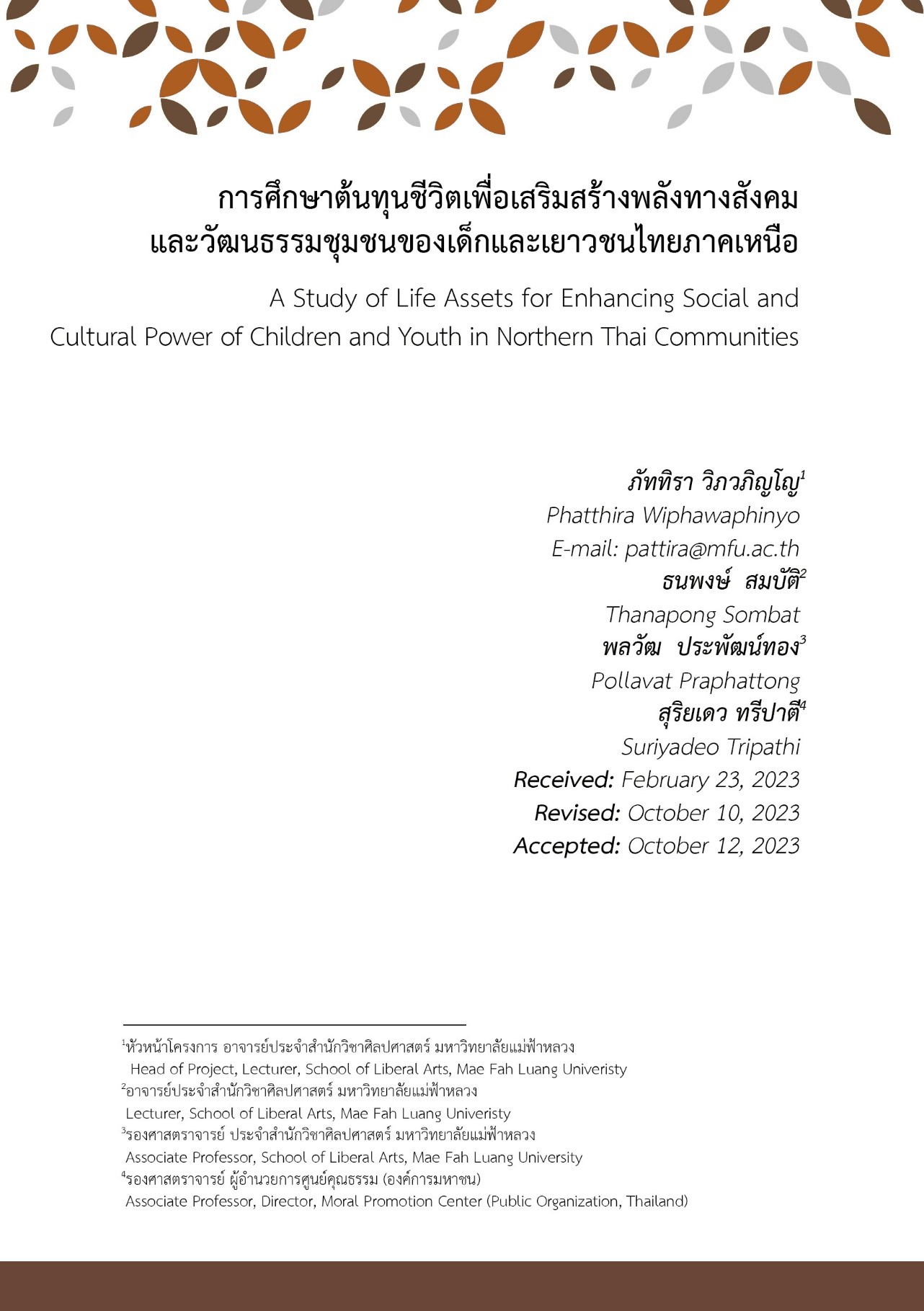A Study of Life Assets for Enhancing Social and Cultural Power of Children and Youth in Northern Thai Communities การศึกษาต้นทุนชีวิตเพื่อเสริมสร้างพลังทางสังคมและวัฒนธรรมชุมชนของเด็ก และเยาวชนไทยภาคเหนือ
Main Article Content
Abstract
This research article aims to study the life assets of children and youth in northern Thailand in order to use the results from the study to support the design of a process for enhancing social and cultural power for children and youth at both policy and operational levels. The samples consisted of 1,653 Northern Thai children and youth aged between 12-18 years who were randomly selected by provinces to represent the region. Data were analyzed using descriptive statistical methods to analyze the life asset data of the sample group from the Thai Child and Youth Life Asset Questionnaire which consists of 5 powers: self, family, wisdom, peer, and community, including 48 indicators of life assets. Regarding 5 powers of the life asset; power of self received the highest average (70.91%), followed by power of the family (69.98%), power peer (creative activity) (68.48%), power of wisdom (62.97%), and power of community which had an average of 51.66 percent (not pass the criteria). Among all indicators, there were 15 indicators showing as “Failed”. The top 5 indicators, that were the weakest, were “I was assigned a role valuable and beneficial to the community (42.02%)”; “I regularly participated in community service activities (45.84%)”; “I had neighbors who were interested in and encourage me (47.35%)”; “I read books with pleasure on a regular basis (48.32%)” and “I could talk, exchange, and learn about media such as radio, TV, other types of media with teachers regularly (48.84%)”, respectively. The results of the study show significant changes in the life assets of children and youth in the North today who have more confidence in power of self and power of wisdom than power of the family and power of community. While the power of community culture transmission, role model, and the provision of learning information about the virtues and involvement of children and young people in activities have decreased in importance.
Downloads
Article Details

This work is licensed under a Creative Commons Attribution-NonCommercial-NoDerivatives 4.0 International License.
References
Boorasuksakul, T. (2015). Thai youth life assets before teenage. Journal of Mental Health of Thailand, 23(3), 154-165.
Department of Children and Youth. (2018). Child and Youth Development Report 2017. Retrieved from https://www.dcy.go.th/public/mainWeb/ file_download/1646492228199-993076668.pdf
Department of Mental Health. (2021). Mental Health Check-in: check your mental health for yourself. Retrieved from https://checkin.dmh.go.th/ register.php?formType=1
Lortrakul, P. et al. (2009). Research report exploring the cost of life of school-age children. Bangkok: Rajanukul Institute.
Moral Center (Public Organization). (2019). Survey on the life assets of Thai children and youth aged 12-18 years. Retrieved from https://dl.moralcenter .or.th/component/phocacart/item/18-แนะนำหนังสือ/315-รายงานวิจัยการสำรวจต้นทุนชีวิตเด็กและเยาวชนไทยอายุ-12-18-ปี
Nida Poll. (2021). Reveal what 'Gen Z' poll results have?? will tell Thai society. Retrieved from https://www.bangkokbiznews.com/social/946245
Nunnally, J. C., & Bernstein, I. C. (1994). Psychometric theory (3rd ed.). New York: McGraw-Hill.
Search institute. (n.d.). Minneapolis: Developmental Assets lists. Retrieved from http://www.search-institute.
Rajanukul Institute. (2009). Thai Children's Life and Social Care: Intellectual Database Development Project. N. P.: M.P.A.
Tripathi, S. (2010). Life assets for children and youth, strengthen self, family, wisdom, peer and community activities. Retrieved from https://www. fordecthai.org/content/
Tripathi, S. et al. (2013). Project to study the situation of life assets of high school students nationwide. National Institute for Child and Family Development. Nakhon Pathom: Mahidol University.
Tripathi, S. et al. (2019). Survey report life assets for Thai children and youth aged 12-18 years. N. P.: Moral center (Public Organization).
Tripathi, S. et al. (n.d.). A guide to using the survey on the life assets of Thai children and youth (Youth edition). Retrieved from https://new.camri.go.th/เทคโนโลยีสุขภาพจิต/เครื่องมือสำรวจต้นทุนชีวิตเด็กและเยาวชน/
Tripathi, S. (n.d.). Developing the potential of adolescents and youth with positive energy. Retrieved from https://www2.nrct.go.th/Portals/0/data/07-part1/07part2/07part3/by%20 Assoc. Prof. Dr. Suriyadew%20 Tripati.pdf
Tripathi, S. (n.d.). Developing adolescents and youth's potential with positive energy. Retrieved from https://www2.nrct.go.th/Portals/0/data/07-part1/07part2/07part3/ by%20 Assoc. Prof. Dr. Suriyadew%20 Tripati.pdf
Wilailak, L. (2022). Development of tools and moral situation survey with moral indicators in 6 regions (Thai people aged 25-40 years old). N. P.: Moral Center (Public Organization).
Wiphawaphinyo, P. (2012). Discursive practice of behavioral regulation of children and youths in the juvenile training center. (Doctoral dissertation). Mae Fah Luang University, Chiang Rai.


